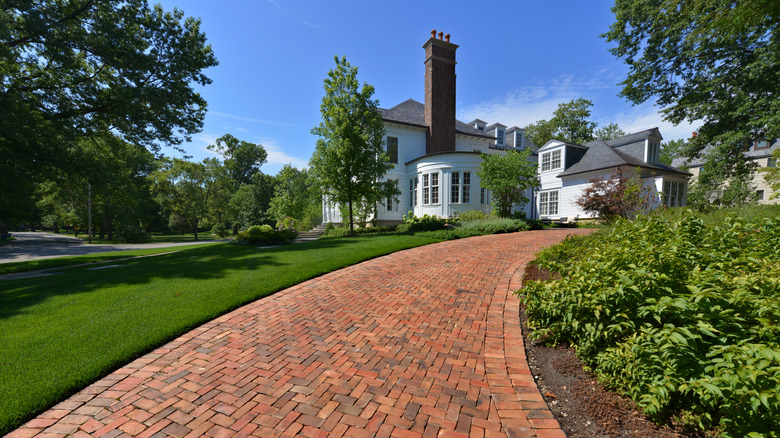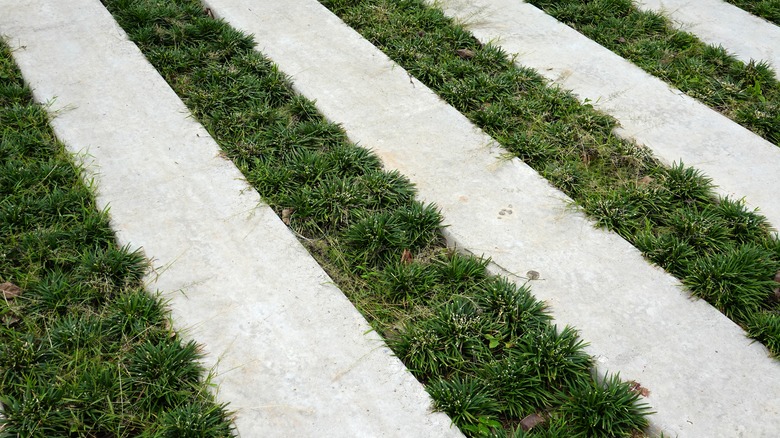The Genius DIY Way To Add Unique Greenery To A Brick Or Stone Pathway
Pathways (and patios, for that matter) are typically the one part of your yard you keep relatively plant-free, at least where the paved surface is concerned. We're suggesting you turn this conservative thinking on its head. Instead of preventing weeds from growing in cracks, you'll strategically create mini garden beds where plants flourish. To achieve this aesthetically pleasing design, lift selected bricks, stones, or pavers to reveal the sand and dirt below, and fill the gaps with quality potting mix, compost, and plants you know will thrive in these specific conditions. This idea — planting between the pavers — works just as well for those with a teeny backyard that's entirely hardscaped as for those with substantial outdoor spaces.
Planting in the gaps of a path or patio isn't new. The famous (or infamous at the time of its creation) moss chequerboard garden crafted by Japanese designer Mirei Shigemori at the ancient Tofuku-ji temple in Kyoto has its roots in earlier European gardening traditions, like the subdivided paths of the Italian Renaissance. In each design, pavers are regularly interspersed with moss, herbs, and other groundcover plants. There's also some overlap with crevice gardening, a style of rock gardening widely attributed to the Chezh Republic garden designer Zdenek Zvolanek (ZZ). The benefits of this style include reducing the need for weeding, making good use of compact spaces, and breaking up the hard surfaces that increase water run-off in our urban and suburban environments. Plus, it looks great!
Get the right plants
Learn what types of plants do well in this setting — namely, a small soil surface area with relatively shallow depth. Grass is an option, but it's a boring one. Look for foot-traffic-resistant ground cover plants you should grow instead of grass, like Corsican mint (Mentha requienii), which sends a fresh minty fragrance into the air each time you brush past it, or Dymondia (Dymondia margaretae), which boasts silver-backed leaves and cute yellow flowers and loves full sun.
Consider, too, whether your paved pathway gets lots of sun, shade, or a mix. If it sees full sun all day, you might do better with hardy desert plants, like low-growing succulents. Get only dappled or deep shade all day? Go for low-light lovers like sweet woodruff (Galium odoratum) and mondo grass (Ophiopogon japonicus). Bonus: These plants are typically very low maintenance, meaning you can pretty much plant and forget — aside from some watering in dry weather, of course.
Do you prefer to put effort into growing edible plants? Choose fast-to-harvest, shallow-rooted vegetables, defined as crops with roots reaching no longer than 18 inches into the soil. Most herbs, lettuce, radishes, spinach, onions, garlic, and "wild greens" like dandelions fit into this category. Harris Seeds sells an organic heirloom lettuce cutting-blend mix — get a packet of 50 seeds for $1.98. Get 200 Rudolf radish seeds, a bright red cherry-sized variety, for $3.95 from San Diego Seed Company. Walmart has a 3-pack spinach seed collection for $10.
Lift the bricks, amend the soil, and plant
Pathway stones typically sit atop a sandy medium, so you'll need to amend the soil with a quality potting mix designed for container gardening — get a 6-quart bag of organic all-purpose peat-free potting mix for 8.99 from Back to the Roots — and some homemade or storebought compost. Use the compost finder on the US Composting Council website to find a supplier near you. Also, purchase some slow-release fertilizer — Lowe's sells a 4.5-pound shaker bottle of Miracle-Gro all-purpose garden fertilizer for $15.98. Tool-wise, have gardening gloves, a shovel or trowel, and a watering can or garden hose handy.
Work out the best layout for your garden, on paper or digitally; it's your guide to which pavers to pull up. Push the blade of your trowel into the gap between pavers and pull the handle to angle the blade upward. As the brick comes away from the ground, grab it, pull it up, and put it to one side. Repeat until all the bricks you want out are out! If you're lucky, the pathway or patio was laid on sand, making lifting the individual tiles out and planting beneath them easy. If they're bedded on aggregate (small rocks) or landscaping fabric, prepare to do a bit more shoveling and some cutting. Fill the holes with soil and compost, and sow your seeds or plant your seedlings using the specific species' instructions. Add a little fertilizer and water until damp and settled.


